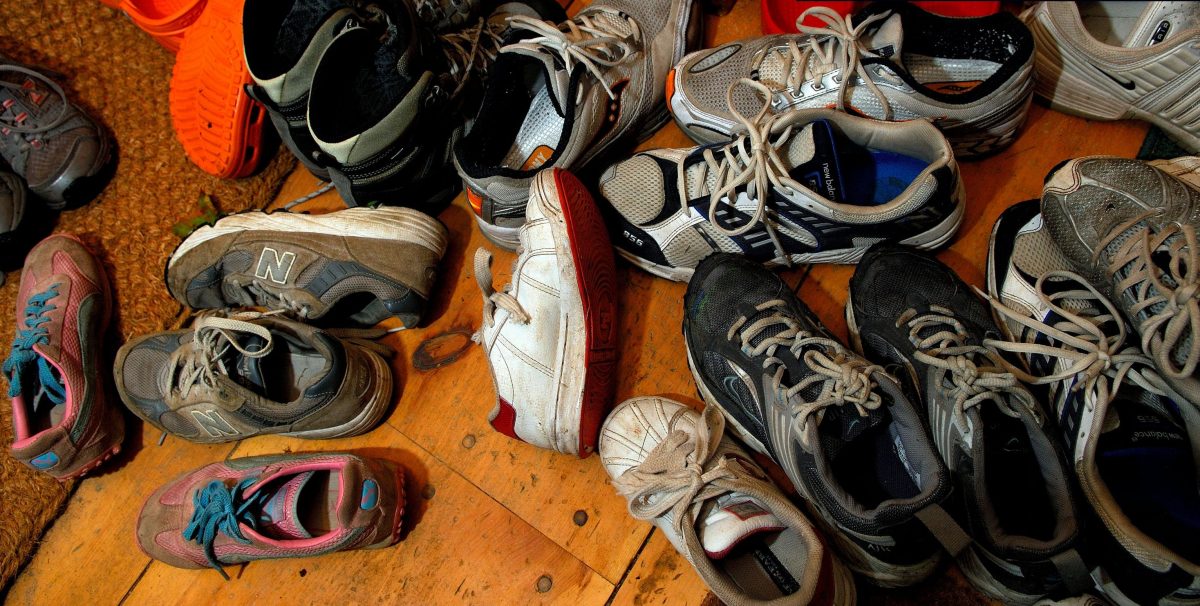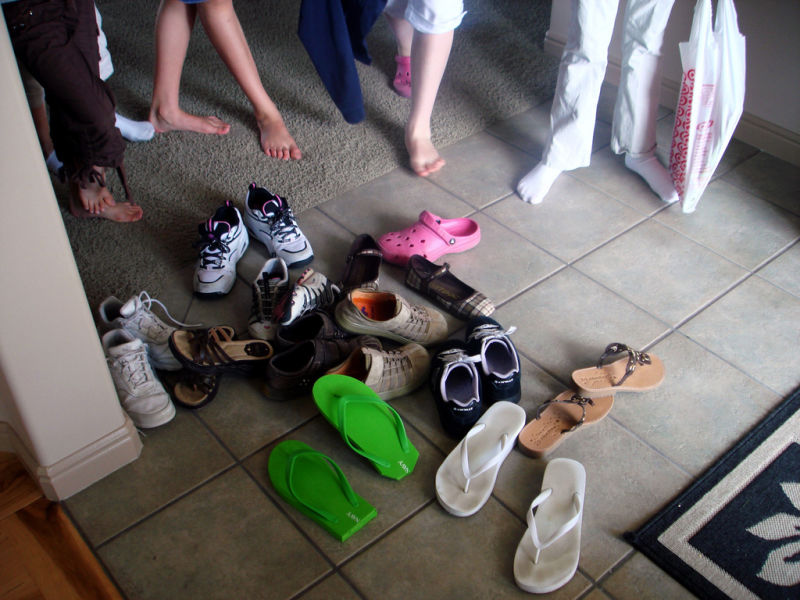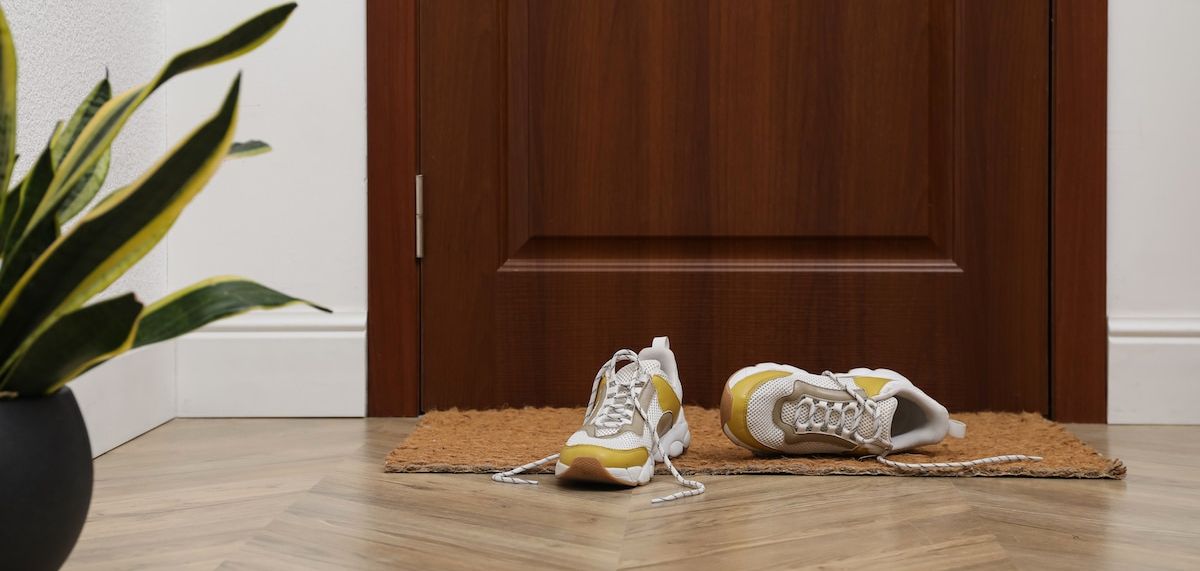Though it may seem unusual to many Western expats – at least at first – the practice of removing shoes before entering a home in Asia is common to the point of being an unspoken rule.
After 15 years of living in Malaysia, I have gotten so accustomed to not wearing shoes in the house that when I watch Western (mostly American) movies and TV series, I almost physically cringe when I see characters not only wearing shoes in the house, but putting their shoe-clad feet on sofas, on the bed, and just about anywhere else you can imagine. As I watch in horror, my inner voice is all but shouting. Shoes on the bed!? No!!
So a couple of questions come to mind for many expats when it comes to the whole ‘shoes off’ thing – why is it done here (almost universally), and is it in any way better than traipsing about the house in your trainers?
Well, it’s not just Malaysia, of course. Throughout Asia, a largely unspoken but very well-known ‘rule’ in private homes mandates the removal of shoes upon entry. In fact, if you’ve been in Asia long enough, you’ll know that it’s common to see a substantial pile of assorted footwear outside house parties, sometimes organized neatly on shoe racks at the entrance or just outside, or more often, just heaped higgledy-piggledy at the entry in a veritable shoe free-for-all.

DOES THE TYPE OF FLOORING MAKE A DIFFERENCE?
The practice of keeping the interior floors free from outdoor shoe contact stems from not-so-distant times when roads and footpaths were often laden with filth. Chinese superstitions reinforce this rule, associating wearing outdoor shoes inside with the introduction of ‘bad luck,’ symbolizing germs, into the home. The custom of going barefoot indoors is unusual; instead, slippers or rubber sandals were commonly worn.
In some early urban centres in Asia, ground floors were typically paved with stone slabs, supporting timber boards on upper levels. This timber, imported mainly from Southeast Asia, became a staple, shaping the architectural landscape. Varnished parquet floors, introduced to provide a stylish timber effect to post-war apartment buildings, became a commonplace feature in many homes, later falling somewhat out of favour. It’s still quite normal to find parquet floors in older homes in and around Kuala Lumpur, though.

The choice of flooring materials througout Asian cities was often influenced by the need for coolness, in addition to aesthetic considerations. English patterned encaustic floor tiles were widely exported to tropical regions from the late 19th century up to about the 1930s. While much of this material was lost during post-war redevelopment in cities like Singapore and Hong Kong, examples can still be found in various structures across South and Southeast Asia, as well as in China’s former treaty ports.
Marble and other stone flooring also features in plenty of Malaysian homes. Marble’s tendency to remain cooler than the air temperature contributes to its popularity. Indeed, marble slab flooring, popular in hot regions like Malaysia, Singapore, Indonesia, and parts of India, provides a cool and aesthetically pleasing touch to buildings.
In some parts of Asia, the popularity of woollen carpets, especially large fitted ones, surged in the 1970s with the widespread adoption of air conditioning. Fitted carpets served a dual purpose, reducing noise in office environments and concealing dust effectively. However, though small area rugs are widely used in Malaysia, fitted or ‘wall-to-wall’ carpeting is exceedingly rare.

Probably the most commonly used flooring material in most city homes in Malaysia is the humble tile, though engineered wood-like flooring has seen a big surge in popularity in recent years.
Whatever the flooring type, though, shoes still remain firmly gathered at the front entryway. Apart from bringing ‘bad luck’ into the home, it’s hard to argue that tracking in dirt and dust by wearing shoes inside is something to be avoided, especially with the hard-surface floors mentioned.
IS REMOVING SHOES ACTUALLY BENEFICIAL?
So there’s definitely a cultural component to the removal of shoes when going into a home, but are there any real benefits to the practice? Specifically, is it more hygienic or healthier? Is there compelling evidence that going shoeless can halt the spread of germs in a home?
“Absolutely,” affirmed Gabriel Filippelli, chancellor’s professor for the department of Earth Sciences at Indiana University-Purdue University Indianapolis and executive director of Indiana University’s Environmental Resilience Institute. “We can track in all sorts of bacteria, but certainly some of the ones we’re most concerned about are E. coli [bacteria],” he said, noting a range of serious gastrointestinal problems which can be caused by the bacteria. “There have been studies that swab the bottom of shoes and something like 99% of the shoes test positive for fecal material.”
However, bacteria isn’t the sole concern hitching a ride with dust and dirt around homes, gardens, and parks, emphasized Jill Litt, a professor of environmental studies at the University of Colorado in Boulder, currently working as a senior researcher at the Barcelona Institute for Global Health, or ISGlobal, in Spain. “Studies have shown that in urban areas where there are older homes, lead in dust can be tracked into the home on the surface of shoes,” she said. “Other studies have shown that you can bring in pesticide residues from gardens via shoes.”
:max_bytes(150000):strip_icc()/GettyImages-115573280-3f415171cd664a92bffececf9b76d3c3.jpg)
Heavy metals such as lead, copper, and zinc pervade urban soils due to decades of pollutants, while pesticide levels can be high in rural agricultural areas, added Litt. In the United States, homes built before 1978 are likely to contain lead-based paint, posing risks, especially to children. This is, unfortunately, still a minor problem in Malaysia, though more prevalent with decorative enamel paints, and less so with wall-covering latex paints. Lead exposure has no safe level, with children being particularly vulnerable due to their small size and close proximity to contaminants.
“For little ones, hand to mouth is one of the primary ways children get exposed to toxic substances and infectious disease agents,” said Litt.
One thing any Malaysian will tell you is that the shoe-free home means you need to ensure your floors are as dirt- and dust-free as possible. If not, you and your family will end up with dirty feet! (Do a quick check to see if this applies to you!) Cleaning pros suggest using wet or spray mops instead of vacuuming or sweeping with a broom, as the latter may stir up dust and toxins. Adding water to dirt might seem counterintuitive, but it’s the best way to remove toxins, noted Litt. Regularly clean horizontal surfaces with a damp cloth and avoid feather dusters.
Carpeted areas, such as large area rugs, should be vacuumed with a high-efficiency particulate air (HEPA) filter vacuum, not bagless vacuums. Smaller rugs can be taken outside and shaken (or, if you’re feeling aggressive, beaten).
While taking off shoes at the door is an effective way to limit germs and potentially toxic dust, guest comfort should be considered. Providing washable slippers or nonslip socks can be a considerate gesture, suggests Filippelli. “I do not like to walk around with bare feet inside, so here’s my hack. I have some slippers right inside my front door — a lot of other cultures do that as well,” he said. (Japan is certainly among them.)

Though this isn’t widely practiced in a lot of Malaysian households, at least in the sense of providing house slippers to visiting guests, I’ve been to some homes where slippers are made available. That’s more of the exception than the rule, however, at least in my experience. Malaysians just tend to keep their floors at home quite clean, and the rise of smart robot vacuums, including the combo vac and mop units, have made keeping floors clean easier than ever.
So while I’m not sure if or when I’ll ever return to my home country, if I do, the ubiquitous Asian ‘shoes off’ practice will be something I definitely take back with me!

"ExpatGo welcomes and encourages comments, input, and divergent opinions. However, we kindly request that you use suitable language in your comments, and refrain from any sort of personal attack, hate speech, or disparaging rhetoric. Comments not in line with this are subject to removal from the site. "





















